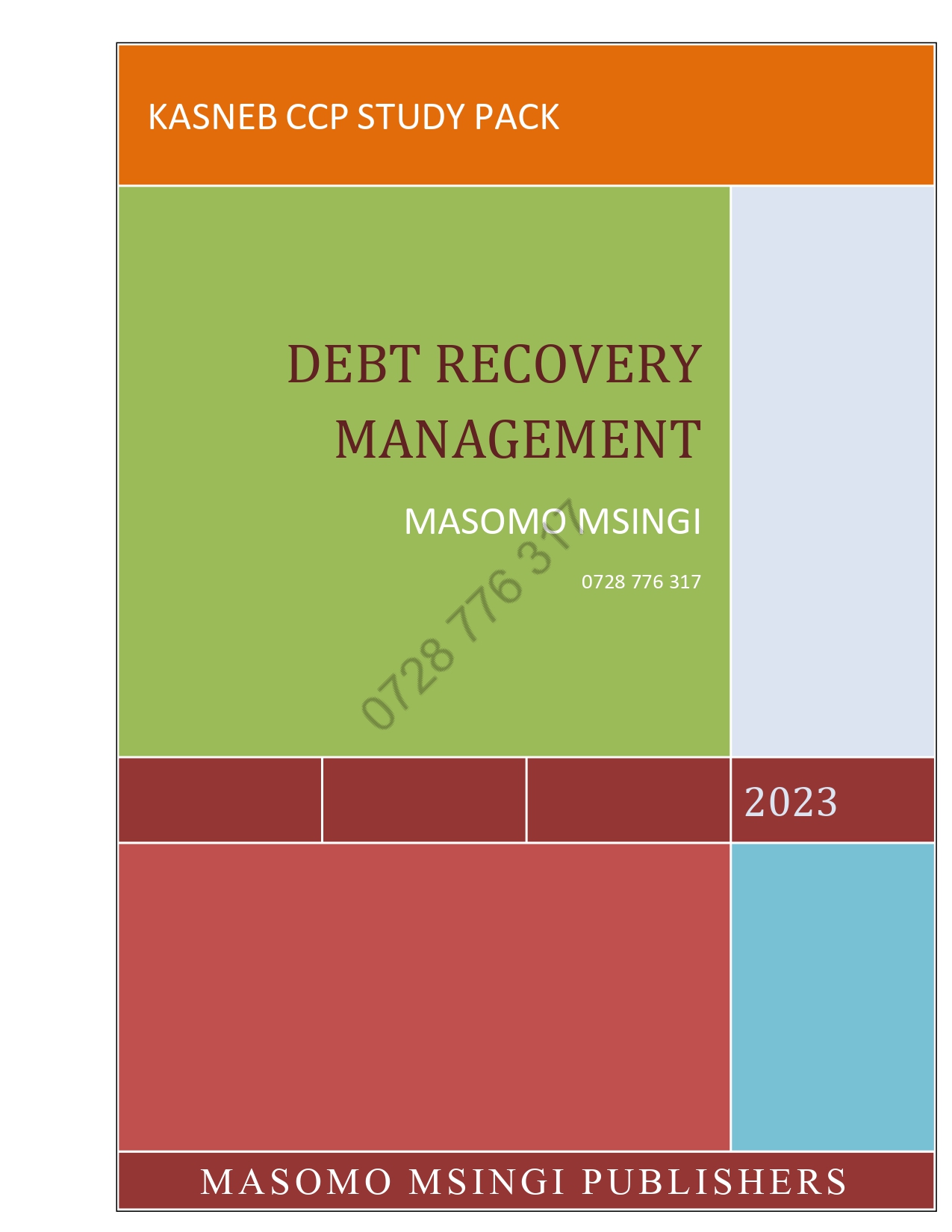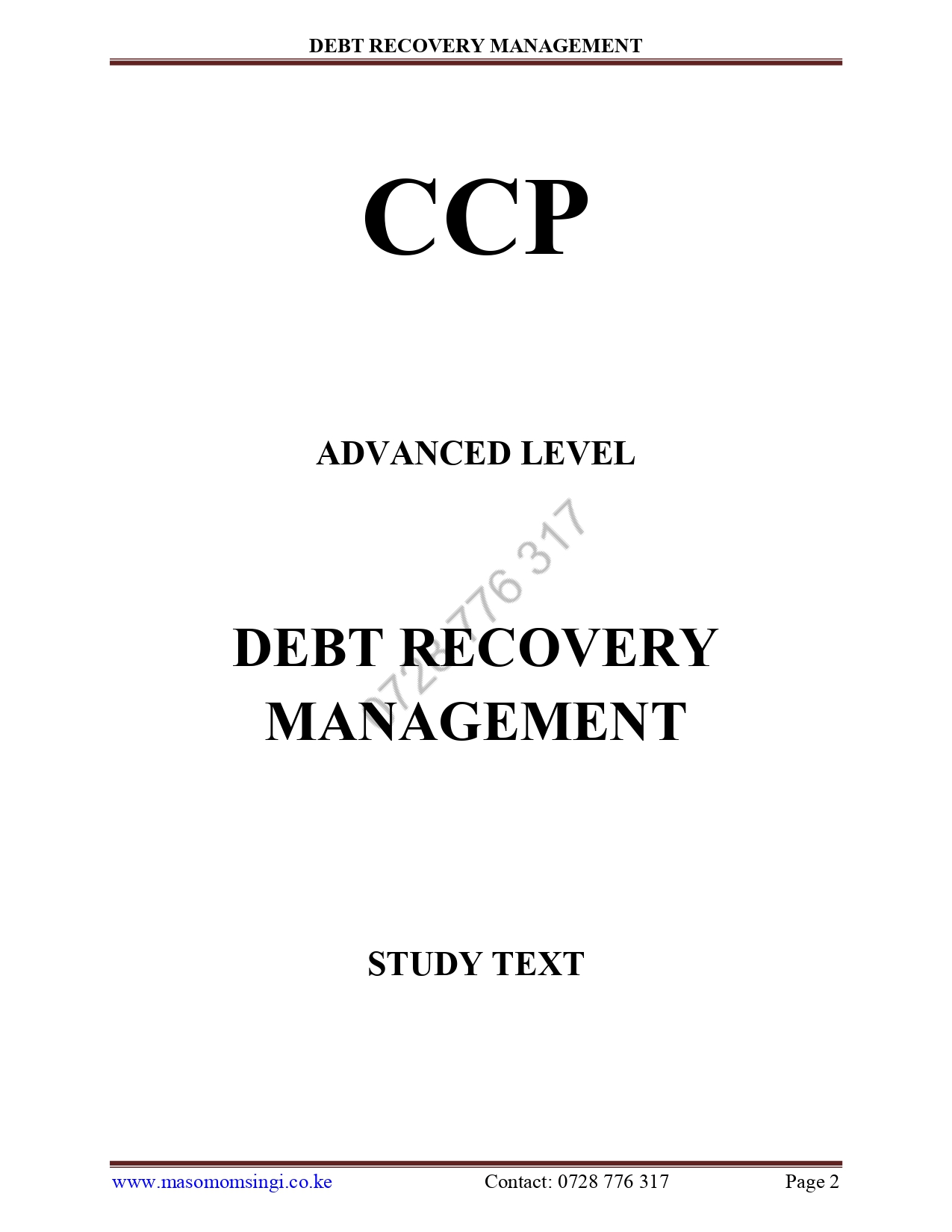MASOMO MSINGI PUBLISHERS APP – Click to download and access all our materials in PDF


PAPER NO. 14 DEBT RECOVERY MANAGEMENT
COMPETENCE
This paper is intended to equip the candidate with knowledge, skills and attitudes that will enable him/her to effectively apply insolvency laws in debt recovery and management of debt recovery work for a range of customers in line with legal, regulatory and industry frameworks.
LEARNING OUTCOMES
A candidate who passes this paper should be able to:
- Employ insolvency proceedings for recovery of debts effectively.
- Advise on recovery of debts under partnerships dissolution.
- Evaluate viability of recovery of debts through cross border insolvencies.
- Evaluate commercial viability in closure of credit obligations.
- Assess the options available in the recovery of debts.
- Prepare for selected debt recovery actions and manage debt recovery procedures and processes
CONTENT
1. Insolvency regimes and legal framework.
- Natural persons
- Partnerships
- Corporations – Artificial persons
- Cross-border insolvencies
- Debt (Summary Recovery) Act – Highlights
- Auctioneers Act – Highlights
2. Insolvency of Natural persons
- Meaning – Insolvency and bankruptcy
- Nature of bankruptcy
- Bankruptcy proceedings
- Rights of creditors
- Consequences of bankruptcy
- Discharge of a bankrupt
3. Alternatives to bankruptcy
- No asset procedure
- Summary Instalments order
- Voluntary Arrangements
- Proposal to Creditors
4. Dissolution of Partnerships
- Break-up of a partnership and its effects of break-up
- Restriction of ceasing to be a partner on or after break-up
- Protection of property acquired after break-up
- Winding up by partners
- Distribution of partners’ assets on winding up
- Dissolution of a partnership which has broken up
- Appointment of the administrator and provisional liquidator
- Power of court to fix remuneration of receivers and managers
- Appointment of a receiver as liquidator
- Provisions relating to receiver or manager appointed
5. Corporate Insolvency
- Meaning of corporate insolvency
- Receivership
- Types of liquidation – Members’ voluntary, Creditors Voluntary and Liquidation by court order
- Official receiver/liquidator
- Committee inspection
- Distribution of assets and priority of claims
6. Debt Management via Arbitration
- Interpretation of arbitration – Domestic and international arbitration
- Appointment and discharge of an arbitrator
- Conduct of Arbitral proceedings
- Arbitral award and its enforcement
- Other ADR mechanisms – Mediation, Negotiation and conciliation
7. Cross-border insolvencies
- Model Law on cross-border insolvencies
- United Nations Commission on International Trade Law (UNCITRAL) legislative guide on insolvency law
- Principles for effective Insolvency & Creditor/debtor regimes – World Bank
8. The Auction Process
- Meaning
- Understanding the Auction process
- Complaints against the auctioneers
- Rights to recover damages from Auctioneers
- Appeals handling

SAMPLE WORK
Complete copy of CCP Debt Recovery Management Revised Notes is available in SOFT copy (Reading using our MASOMO MSINGI PUBLISHERS APP) and in HARD copy
Phone: 0728 776 317
Email: info@masomomsingi.com
CHAPTER ONE
INSOLVENCY REGIMES AND LEGAL FRAMEWORK
Natural persons
Natural persons, also known as individuals, can be affected by insolvency regimes and legal frameworks in different ways.
- Personal bankruptcy: Natural persons can file for personal bankruptcy, which is a legal process that allows individuals to discharge or reorganize their debts. This process is governed by federal laws, such as the Bankruptcy Code in the United States.
- Debt settlement: Natural persons can also negotiate with their creditors to settle their debts. This process typically involves reaching an agreement with creditors to pay a reduced amount of the debt.
- Debt management: Natural persons can also work with a debt management company to create a debt management plan. This plan can help individuals to better manage their debts and get back on track financially.
- Insolvency proceedings: In some cases, natural persons may be subject to insolvency proceedings, which is a legal process that is used to resolve financial difficulties. This can include liquidation of assets, debt restructuring, and reorganization of financial affairs.
- Legal proceedings: Natural persons may also be subject to legal proceedings, such as civil lawsuits or wage garnishments, as a result of their financial difficulties.
- Credit Counseling: Natural persons can also seek credit counseling, which can provide them with advice and support on managing their debts and improving their credit score.
Natural persons can be affected by insolvency regimes and legal frameworks in different ways, such as personal bankruptcy, debt settlement, debt management, insolvency proceedings, legal proceedings, and credit counseling. It’s important for individuals to understand the options available to them and to seek professional advice when dealing with financial difficulties.
Partnerships
Partnerships, or business entities that are owned and operated by two or more individuals, can be affected by insolvency regimes and legal frameworks in different ways.
- Partnership bankruptcy: Partnerships can file for bankruptcy, which is a legal process that allows the business to discharge or reorganize its debts. This process is governed by federal laws, such as the Bankruptcy Code in the United States.
- Debt settlement: Partnerships can also negotiate with their creditors to settle their debts. This process typically involves reaching an agreement with creditors to pay a reduced amount of the debt.
- Debt management: Partnerships can also work with a debt management company to create a debt management plan. This plan can help the business to better manage its debts and get back on track financially.
- Insolvency proceedings: In some cases, partnerships may be subject to insolvency proceedings, which is a legal process that is used to resolve financial difficulties. This can include liquidation of assets, debt restructuring, and reorganization of financial affairs.
- Legal proceedings: Partnerships may also be subject to legal proceedings, such as civil lawsuits or wage garnishments, as a result of their financial difficulties.
- Dissolution: Partnerships that are unable to pay their debts may decide to dissolve the partnership and terminate the business.
- Restructuring: Partnerships may also decide to restructure the business, by changing the ownership, management, or operations of the partnership, in order to improve the financial performance.
Partnerships can be affected by insolvency regimes and legal frameworks in different ways, such as partnership bankruptcy, debt settlement, debt management, insolvency proceedings, legal proceedings, dissolution and restructuring. It’s important for partnerships to understand the options available to them and to seek professional advice when dealing with financial difficulties.
Corporations – Artificial persons
Corporations, also known as artificial persons, can be affected by insolvency regimes and legal frameworks in different ways.
- Corporate bankruptcy: Corporations can file for bankruptcy, which is a legal process that allows the business to discharge or reorganize its debts. This process is governed by federal laws, such as the Bankruptcy Code in the United States.
- Debt settlement: Corporations can also negotiate with their creditors to settle their debts. This process typically involves reaching an agreement with creditors to pay a reduced amount of the debt.
- Debt management: Corporations can also work with a debt management company to create a debt management plan. This plan can help the business to better manage its debts and get back on track financially.
- Insolvency proceedings: In some cases, corporations may be subject to insolvency proceedings, which is a legal process that is used to resolve financial difficulties. This can include liquidation of assets, debt restructuring, and reorganization of financial affairs.
- Legal proceedings: Corporations may also be subject to legal proceedings, such as civil lawsuits or wage garnishments, as a result of their financial difficulties.
- Liquidation: Corporations that are unable to pay their debts may decide to liquidate their assets and terminate the business.
- Mergers & Acquisition : Corporations may also decide to merge with or acquire other companies in order to improve the financial performance.
- Restructuring: Corporations may also decide to restructure the business, by changing the ownership, management, or operations of the corporation, in order to improve the financial performance.
Corporations can be affected by insolvency regimes and legal frameworks in different ways, such as corporate bankruptcy, debt settlement, debt management, insolvency proceedings, legal proceedings, liquidation, mergers & acquisition, and restructuring. It’s important for corporations to understand the options available to them and to seek professional advice when dealing with financial difficulties.
Cross-border insolvencies
Cross-border insolvencies occur when a company or individual with assets and liabilities in more than one country becomes insolvent. These types of insolvencies can be more complex to manage and resolve due to the different laws, regulations, and cultural norms that may apply in different countries.
- Multiple proceedings: Cross-border insolvencies may involve multiple proceedings in different countries, which can make the process more complex and time-consuming.
- Conflicting laws: Different countries have different laws and regulations regarding insolvency, which can lead to conflicting decisions and outcomes.
- Priority of claims: In cross-border insolvencies, there may be disputes over the priority of claims, which can affect the distribution of assets among creditors.
- Recognition of foreign proceedings: In some cases, foreign courts may not recognize or enforce the decisions made in the primary insolvency proceedings, which can lead to delays and added costs.
- Coordination: Cross-border insolvencies require coordination among multiple stakeholders, including courts, creditors, and insolvency practitioners, which can be challenging.
- Cultural differences: Cultural differences can also affect the communication and negotiation process between the parties involved, which can further complicate the resolution of cross-border insolvencies.
- International legal frameworks: there are international legal frameworks to help in cross-border insolvency such as The United Nations Commission on International Trade Law (UNCITRAL) Model Law on Cross-Border Insolvency, and the European Union Insolvency Regulation (EIR) which helps in the coordination of proceedings across EU member states.
Cross-border insolvencies can be more complex to manage and resolve than domestic insolvencies due to the different laws, regulations, and cultural norms that may apply in different countries, conflicting laws, priority of claims, recognition of foreign proceedings, coordination, cultural differences and the need of international legal frameworks.
Debt (Summary Recovery) Act – Highlights
The Debt (Summary Recovery) Act is a law that regulates the summary recovery of debts in some countries like New Zealand. The act provides a streamlined process for the recovery of small debts, such as those under a certain threshold, without the need for court proceedings.
- Debt threshold: The act sets a threshold for the amount of debt that can be recovered through the summary recovery process. Only debts that fall below this threshold are eligible for summary recovery.
- Demand notice: The act requires the creditor to serve a demand notice on the debtor before starting the summary recovery process. The demand notice must include the amount of the debt, the date by which the debt must be paid, and information about the debtor’s rights.
- Warrant of execution: If the debtor fails to pay the debt within the time period specified in the demand notice, the creditor can apply to the court for a warrant of execution. This allows the creditor to seize and sell the debtor’s assets to recover the debt.
- Objections: The act allows the debtor to object to the summary recovery process by filing a notice of objection with the court. The court will then review the case and decide whether to proceed with the summary recovery or refer it to a full trial.
- Appeal: The act provides for the right of appeal for both the debtor and creditor, in case of any dissatisfaction with the court’s decision.
- Limitations: The act sets limitations on the types of assets that can be seized and sold, as well as the amount of debt that can be recovered through the summary recovery process.
The Debt (Summary Recovery) Act provides a streamlined process for the recovery of small debts, but also provides rights and protection for the debtor throughout the process, and limits the amount of debt that can be recovered, and the types of assets that can be seized.
